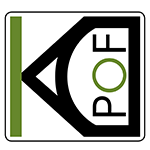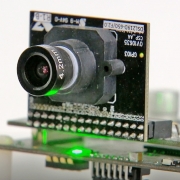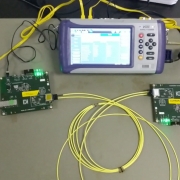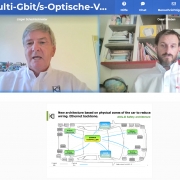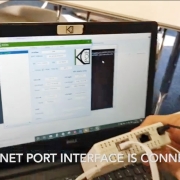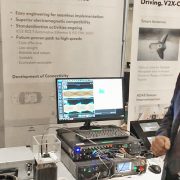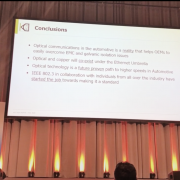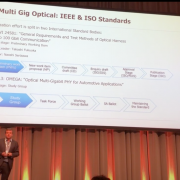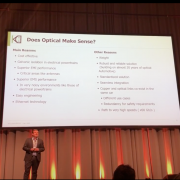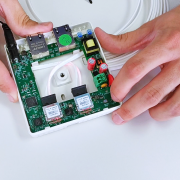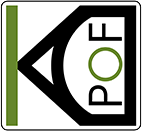TV Report by RTVE: We visited the Digital Enterprise Show 2021, a very special edition that addresses digital and technological transformation. Spanish company KDPOF has created a new technology to transmit data at high speed over plastic optical fiber.
(The part with KDPOF starts at app. 4:15)
Carlos Pardo speaks to Sanjay Gangal of edacafe.com. Key questions have been: What are the key challenges for connectivity in electric vehicles? How can the cost issue be met? With autonomous driving ahead, the bandwidth required will speed up beyond one gigabit. How will the upcoming automotive network be able to meet speed and cost requirements?

By loading the video, you agree to YouTube's privacy policy.
Learn more

By loading the video, you agree to YouTube's privacy policy.
Learn more
The automotive evaluation kit contains:
- 2 SFP-POF media converter boards
- 15 meters/4 in-line connectors POF harness or 40 meters/0 in-line connectors POF harness
- 1000BASE-T SFP modules/UTP & SFP twinax cables
- USB2ALL POF link

By loading the video, you agree to YouTube's privacy policy.
Learn more
Optical network technology overcomes these trends thanks to its inherent galvanic isolation, robustness, low cost, and low weight. Carmakers will benefit from optical links for communications between the 48-volt and the 12-volt domains. For weight, the optical network will save more than 30 percent of the equivalent copper-based harness weight. Optical Ethernet provides 100 Mb/s and 1 Gb/s network solutions today, and multi-gigabit Ethernet is the significant upcoming breakthrough for in-vehicle networks. The standardization effort for optical multi-gigabit is already in progress within the IEEE as an amendment to the Ethernet standard 802.3.

By loading the video, you agree to YouTube's privacy policy.
Learn more
Installing POF in the home is very fast and simple but, like other communication installations, it should be verified. The typical way to confirm that the installation is working is to check the link LED indicators. But this provides no indication of how well or how badly the POF link is working. It makes a difference because optical communication suffers attenuations from the fiber length, bending, a bad cut or bad insertion. An installation working close to the sensitivity limit may fail in the future due to small extra attenuations (aging, thermal changes, equipment is hit, etc.)
In order to ensure that the installation has been done properly and is operating with a sufficient margin, checking the link quality is recommended. This video demonstrates the KDPOF debugging tool. It allows monitoring of the POF links in an installation where a KDPOF daisy-chain outlet is used. The monitor application will give information about the outlet ID, operating time, connected ports speed and, of course, the link margin of the optical ports.
List of materials used in the video:
- 2x POF media converters + PSUs
- 1x POF daisy chain outlet + PSU
- POF cable
- 2x laptop
- 1x STB
- 3x UTP cable
- KDPOF monitoring tool

By loading the video, you agree to YouTube's privacy policy.
Learn more
KDPOF proudly displayed the world’s first demonstration of an automotive-grade optical transmission system with 50 gigabits per second single lane at the Automotive Ethernet Congress in February 2020 in Munich, Germany. In-vehicle networks are on the brink of speeds from one to multiple gigabits per second. With the approval of the IEEE 802.3 working group, a team of individuals affiliated with more than 15 key carmakers and components suppliers, including KDPOF, has started the standardization of an IEEE 802.3 Automotive Optical Multi-Gigabit Standard with strong support from the industry. The study group evaluates the creation of an IEEE Ethernet standard for the automotive industry, with speeds starting at 2.5 Gb/s, going up to 25 or 50 Gb/s, and scalable up to 100 Gb/s. The key advantages of the optical solution for specific applications using multi-gigabit speeds with in-vehicle connectivity are, among others, Electromagnetic Compatibility (EMC) thanks to the inherent galvanic isolation, low weight, and low cost.

By loading the video, you agree to YouTube's privacy policy.
Learn more
Carlos Pardo, KDPOF CEO, speaking about Optical Multi-Gigabit Ethernet on the Verge of Standardization and Implementation at the Automotive Ethernet Congress in February 2020 in Munich, Germany. With the approval of the IEEE 802.3 working group, a team of individuals affiliated with more than 15 key carmakers and components suppliers, including KDPOF, has started the standardization of an IEEE 802.3 Automotive Optical Multi-Gigabit Standard with strong support from the industry. The key advantages of the optical solution for specific applications using multi-gigabit speeds with in-vehicle connectivity are, among others, Electromagnetic Compatibility (EMC) thanks to the inherent galvanic isolation, low weight, and low cost.

By loading the video, you agree to YouTube's privacy policy.
Learn more
Carlos Pardo, KDPOF CEO, speaking about Optical Multi-Gigabit Ethernet on the Verge of Standardization and Implementation at the Automotive Ethernet Congress in February 2020 in Munich, Germany. In-vehicle networks are on the brink of speeds from one to multiple gigabits per second. With the approval of the IEEE 802.3 working group, a team of individuals affiliated with more than 15 key carmakers and components suppliers, including KDPOF, has started the standardization of an IEEE 802.3 Automotive Optical Multi-Gigabit Standard with strong support from the industry. The study group evaluates the creation of an IEEE Ethernet standard for the automotive industry, with speeds starting at 2.5 Gb/s, going up to 25 or 50 Gb/s, and scalable up to 100 Gb/s.

By loading the video, you agree to YouTube's privacy policy.
Learn more
Carlos Pardo, KDPOF CEO, speaking about Optical Multi-Gigabit Ethernet on the Verge of Standardization and Implementation at the Automotive Ethernet Congress in February 2020 in Munich, Germany. The key advantages of the optical solution for specific applications using multi-gigabit speeds with in-vehicle connectivity are, among others, Electromagnetic Compatibility (EMC) thanks to the inherent galvanic isolation, low weight, and low cost.

By loading the video, you agree to YouTube's privacy policy.
Learn more
Installing POF will help to improve the Internet connectivity in the home. A POF link can cover up to 50 m, giving 1 Gb/s performance. The installation does not require high level skills and can be done with simple tools. POF cable is typically installed through the existing conduits in the house, so it’s easy to reach any room and keep the cable hidden.
This video shows how to connect and check a daisy-chain (DC) POF installation by using commercial equipment. Key points are the simplicity and quickness of the cut and connect. The daisy chain POF outlet consists of two RJ45 copper ports and two optical POF ports. It allows installations in DC topology, which can cover multiple rooms.
List of materials used in the video:
- 2x POF media converters + PSUs
- 1x POF daisy chain outlet + PSU
- POF cable
- 2x laptop
- 1x STB
- 3x UTP cable
- KDPOF monitoring tool
